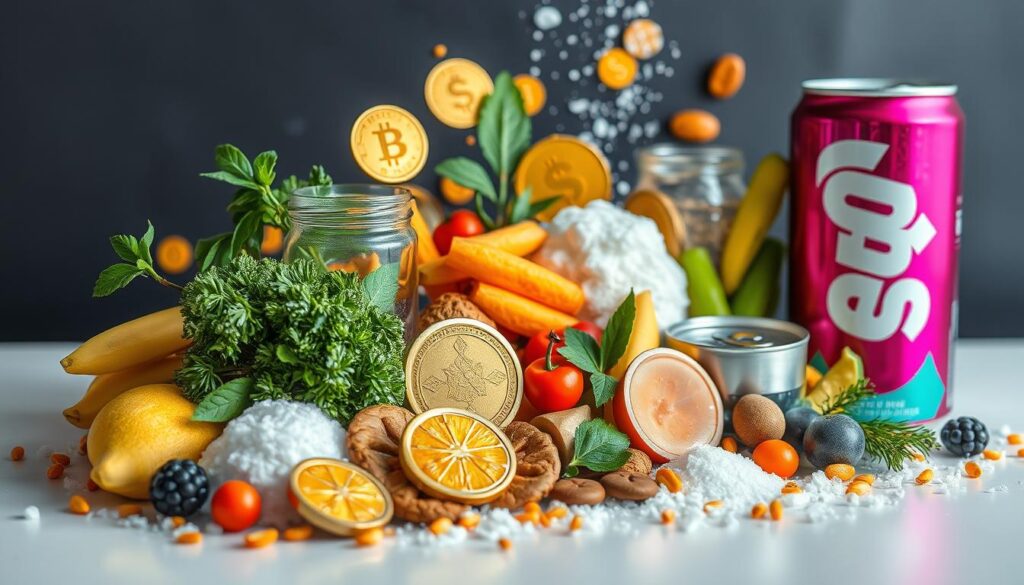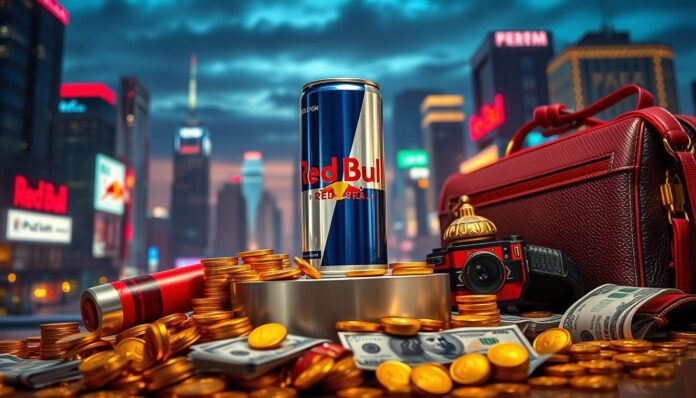Ever wondered why Red Bull costs more than other energy drinks? It’s about the way they price their premium drink. We’ll look into why Red Bull is priced higher, focusing on branding, marketing, and quality of ingredients. This insight will help you see why Red Bull stands out in the crowded energy drink market. Let’s dive into the reasons behind its price!
Key Takeaways
- Red Bull’s pricing is reflective of its premium brand positioning.
- High-quality ingredients play a significant role in determining costs.
- Effective marketing strategies greatly influence consumer perception.
- Understanding distribution and supply chain costs is crucial.
- Consumer loyalty contributes to Red Bull’s ability to maintain higher prices.
The Premium Positioning of Red Bull
Red Bull has made its mark by choosing a special spot in the energy drink market. It’s seen as a top choice by shoppers. This direction is based on having a strong brand, which really affects how people view energy drinks. The brand suggests an exciting lifestyle, backed by creative marketing and sponsorships.
The Importance of Brand Image
Having a powerful brand image is critical in what consumers decide to buy. Red Bull gives its products a unique vibe that draws people in. This vibe is all about thrill and doing well, making folks want to be part of Red Bull’s lively world. As a result, Red Bull’s image shines brighter than its rivals, earning it a group of loyal buyers ready to spend more.
How Premium Packaging Influences Perception
Premium packaging makes energy drinks seem more appealing. Red Bull’s unique can design grabs your eye and suggests luxury and style. The cool and modern look of the packaging pushes the idea of high quality. It supports Red Bull’s place as a leader. This smart approach to packaging supports the higher price of Red Bull over cheaper options, swaying buyers towards choosing what seems like a more luxurious product.
Why Is Red Bull So Expensive
Understanding the pricing of energy drinks shows how brands position themselves in the market. Red Bull is more expensive than rivals like Monster and Rockstar. This part looks at why Red Bull’s price is higher, despite the tight competition.
Analyzing Price Comparisons with Other Energy Drinks
In the energy drink world, prices can be quite different. A 16-ounce can of Red Bull might be about $3.00. In contrast, Monster or Rockstar of the same size may cost between $1.50 and $2.00. This makes us wonder why Red Bull is priced higher.
Several factors explain Red Bull’s higher price. Marketing, ingredients, and the brand’s image play big roles. Unlike others, Red Bull focuses on being seen as exclusive and of high quality.
| Brand | Price (16 oz) | Market Positioning |
|---|---|---|
| Red Bull | $3.00 | Premium |
| Monster | $1.75 | Value |
| Rockstar | $1.50 | Value |
The data shows clear differences between Red Bull and its competitors. It highlights Red Bull’s decision to stay premium, even if others lower their prices. This strategy keeps its customer base loyal, valuing quality over price, and keeps Red Bull leading in the energy drink market.
The Ingredients Behind the Cost
When we look into the Red Bull ingredients cost, it tells us a lot about its higher price. Red Bull uses a mix of top-notch ingredients. These are chosen very carefully. This selection plays a big part in how much it costs to make Red Bull. It also affects how much it costs to buy it.
High-Quality Ingredients and Their Impact on Pricing
Red Bull has several key ingredients that make it stand out. These include:
- Caffeine: A well-known stimulant that increases alertness and improves focus.
- Taurine: An amino acid that plays a vital role in various bodily functions and may enhance physical performance.
- B-vitamins: Important for energy metabolism and maintaining overall health.
These premium ingredients mean higher production costs. But they make people see the drink as more valuable. This justifies its price. This shows how Red Bull is dedicated to making a drink that supports an active way of living. It also helps Red Bull stand out in the market.
Comparing Ingredients with Competitors
Let’s look at how Red Bull’s ingredients compare to other energy drinks. Below is a table that shows this comparison:
| Ingredient | Red Bull | Competitor A | Competitor B |
|---|---|---|---|
| Caffeine | 80 mg | 70 mg | 100 mg |
| Taurine | 1000 mg | 500 mg | 1000 mg |
| B-vitamins | 100% RDA | 50% RDA | 75% RDA |
This table shows that Red Bull focuses on quality. Some competitors might have more caffeine. But Red Bull’s mix of high-quality ingredients makes it more effective. This impacts its price strategy.

Marketing Expenses Red Bull
Red Bull has a strong marketing approach, which adds a lot to its costs. The company prioritizes creative ads to stay ahead in the fierce energy drink competition. It links its brand with lively events and activities, showing itself as a top choice and upholding its high-end image among buyers.
Advertising Strategies and Campaigns
At the heart of Red Bull’s marketing lies unique advertising for energy drinks. The brand uses social media to launch viral campaigns that grab people’s attention. With exciting content, Red Bull reaches its target audience and keeps up its market presence. This commitment to marketing significantly raises the product’s price.
Sponsorships and Event Marketing
Sponsorships are essential in the energy drink industry. Red Bull connects with diverse areas such as extreme sports and entertainment. This approach not only raises brand awareness but also builds genuine relationships with consumers. Major events like the Red Bull Air Race and the Red Bull Cliff Diving World Series show how the brand uses events for stronger positioning.
Staying Relevant in a Competitive Market
Red Bull always changes its marketing to outdo the competition. This change helps attract young people who look for new thrills. The brand uses stories in its marketing to engage and keep a dedicated following. So, Red Bull’s big marketing spending is worth it for keeping its lead.
Distribution Costs Red Bull
Looking into Red Bull’s distribution costs gives us insights into their pricing. Their supply chain is complex and needs careful planning. Because energy drinks can spoil, logistics is key to keeping Red Bull fresh and available everywhere.
Understanding the Supply Chain
Red Bull’s energy drink journey involves many steps. This journey starts with getting ingredients and ends with the drinks in stores. There are key stages:
- Ingredient procurement
- Manufacturing and bottling
- Transportation and logistics
- Warehousing and inventory management
Costs come up at each stage, affecting how much we pay. It’s important to manage these steps well to keep the drinks good and in stock.
The Role of Retail Partnerships
Retail partnerships are big for Red Bull’s distribution costs. These deals help Red Bull stand out in stores. Sometimes, getting better shelf spots costs more, but it can lead to more sales.
Working well with big stores can help Red Bull cut distribution costs and be more visible. This makes the drink pricier for us, but also more available.
| Supply Chain Step | Key Activities | Cost Factors |
|---|---|---|
| Ingredient Procurement | Sourcing and purchasing raw materials | Quality and availability of ingredients |
| Manufacturing | Bottling and packaging | Equipment maintenance and labor |
| Transportation | Shipping to distribution centers | Fuel prices and shipping routes |
| Retail Distribution | Delivering products to retailers | Fees for shelf space and merchandising |
Brand Premium Red Bull
Red Bull’s brand premium shows strong consumer loyalty. Fans often pay more for Red Bull than other drinks. This is because they love its unique taste and how it boosts energy.
But it’s not just about the drink. For many, Red Bull means a certain lifestyle. This deep connection boosts Red Bull’s image beyond just an energy drink.
Consumer Loyalty and Willingness to Pay
Red Bull’s fan loyalty is impressive. Because of this, many overlook cheaper options. These loyal customers trust Red Bull for its quality and effect.
This trust means they’re willing to pay more. They see the extra cost as a sign of Red Bull’s superior value.
The Psychology of Pricing
Understanding pricing psychology is key in energy drinks. Higher prices often signal better quality to buyers. This supports Red Bull’s position as a market leader.
The pricing strategy isn’t just about the cost. It connects emotionally with customers. They feel the premium price boosts their performance and lifestyle.

| Aspect | Red Bull | Competitor A | Competitor B |
|---|---|---|---|
| Price per Can | $2.50 | $1.50 | $1.80 |
| Consumer Loyalty Level | High | Medium | Low |
| Perceived Quality | Premium | Standard | Standard |
| Brand Recognition | High | Medium | Low |
Energy Drink Pricing Dynamics
The energy drink market changes due to many factors that affect prices. People now prefer healthier options, making brands change their products. Knowing these market factors energy drinks helps understand companies’ pricing methods.
Factors Influencing the Market
Many things influence energy drink prices, such as:
- Health Trends: People caring more about health makes clean-label products more popular.
- Ingredient Quality: Drinks with natural, high-quality ingredients usually cost more.
- Marketing Strategies: Strong advertising makes products seem more valuable, leading to higher prices.
- Distribution Channels: Using direct-to-consumer or retail methods affects the price.
Trends in the Energy Drink Sector
Current trends in the energy drink field show how the market is changing:
- Functional beverages are becoming popular with health-focused consumers.
- New flavors and packagings are drawing in the youth.
- Better availability in stores increases spur-of-the-moment buys.
- Being eco-friendly in production influences costs and prices.
Understanding these trends helps analyze price changes and what influences buyers. Keeping up with this info is valuable for both shoppers and business experts.
Red Bull Cost Breakdown
Most people don’t realize how many expenses go into making Red Bull. Knowing the cost of producing the energy drink sheds light on its retail price. The factors we’ll discuss show Red Bull’s dedication to quality and performance.
Factors Contributing to Production Costs
Red Bull costs a lot because it uses quality ingredients. These are more expensive but vital for the drink’s unique blend. This formula requires ingredients from around the world, adding to the cost. Moreover, strict quality checks and meeting regulations make production pricier.
Are There Hidden Costs?
There are unseen costs in the price of energy drinks. A big factor is marketing. Ads and sponsoring big events affect the product’s final cost. Recognizing these costs helps us understand what we’re really paying for, beyond the drink itself.
Conclusion
The pricing of Red Bull is influenced by several key factors. Its marketing, quality ingredients, and strong distribution network all affect its cost. These elements help create a valuable image for the drink among customers.
Red Bull’s price points to more than just its brand. It reflects the effort put into creating a top-notch drink experience. Customers who stick with the brand feel that the cost is worth it for the energy and reliability it offers.
By understanding these pricing factors, buyers can make better choices. They can decide whether the benefits of Red Bull are worth it compared to other drinks. This insight helps in choosing the right energy drink wisely.
